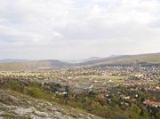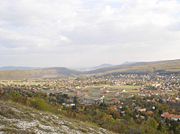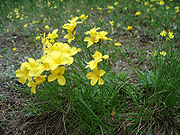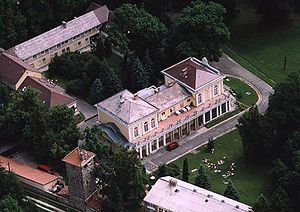
Nagykovácsi
Encyclopedia

Nagykovácsi is a small town in the Pilisvörösvári kistérség district of Hungary
Hungary
Hungary , officially the Republic of Hungary , is a landlocked country in Central Europe. It is situated in the Carpathian Basin and is bordered by Slovakia to the north, Ukraine and Romania to the east, Serbia and Croatia to the south, Slovenia to the southwest and Austria to the west. The...
situated some 15 km (9 mi) north-east of the centre of Budapest
Budapest
Budapest is the capital of Hungary. As the largest city of Hungary, it is the country's principal political, cultural, commercial, industrial, and transportation centre. In 2011, Budapest had 1,733,685 inhabitants, down from its 1989 peak of 2,113,645 due to suburbanization. The Budapest Commuter...
, in a valley, at an altitude of 340 metres. It is located next to the second district of Budapest. In December 2007 its population was given as 6,128 by the town council (Nagykovácsi Nagyközség Önkormányzat), though this figure does not include the many people who own a property there as a second residence. The town is known for the natural beauty of its surrounding hills and forests and many parts of the nearby forest have been designated conservation area
Conservation area
A conservation areas is a tract of land that has been awarded protected status in order to ensure that natural features, cultural heritage or biota are safeguarded...
s—Budai Tájvédelmi Körzet (the "Buda
Buda
For detailed information see: History of Buda CastleBuda is the western part of the Hungarian capital Budapest on the west bank of the Danube. The name Buda takes its name from the name of Bleda the Hun ruler, whose name is also Buda in Hungarian.Buda comprises about one-third of Budapest's...
Land Protection Area")—in order to protect several rare species of flora growing there.
From archaeological finds it is known that this region has been inhabited since time immemorial. Objects found in the caves of the Remete ravine and along the banks of Ördög
Ordog
An Ördög is a demonic creature from Hungarian mythology which personifies the dark aspects of the world. In Christian times, it was identified with the devil....
indicate that people lived here during the Ice
Ice age
An ice age or, more precisely, glacial age, is a generic geological period of long-term reduction in the temperature of the Earth's surface and atmosphere, resulting in the presence or expansion of continental ice sheets, polar ice sheets and alpine glaciers...
, Iron
Iron Age
The Iron Age is the archaeological period generally occurring after the Bronze Age, marked by the prevalent use of iron. The early period of the age is characterized by the widespread use of iron or steel. The adoption of such material coincided with other changes in society, including differing...
, and Stone
Stone Age
The Stone Age is a broad prehistoric period, lasting about 2.5 million years , during which humans and their predecessor species in the genus Homo, as well as the earlier partly contemporary genera Australopithecus and Paranthropus, widely used exclusively stone as their hard material in the...
ages. Various tools, coins and fragments of stone statues unearthed in the area show that there were inhabitants, too, under the Roman Empire
Roman Empire
The Roman Empire was the post-Republican period of the ancient Roman civilization, characterised by an autocratic form of government and large territorial holdings in Europe and around the Mediterranean....
. Of these stone fragments, the most interesting were embedded in the wall of the local church when it was built.
In medieval records, Nagykovácsi is referred to as Koachi and Kowachy. These names indicate that royal smiths viz. ironsmiths (kovács), lived in the town.
The first local document still in existence, a deed of gift, dates from 1254. During the Turkish occupation in Hungary, in the middle of the 16th Century, the village suffered much destruction and the population fell sharply. Once the Turks had been driven out, the Habsburg
Habsburg
The House of Habsburg , also found as Hapsburg, and also known as House of Austria is one of the most important royal houses of Europe and is best known for being an origin of all of the formally elected Holy Roman Emperors between 1438 and 1740, as well as rulers of the Austrian Empire and...
family who reigned in Hungary invited Swabia
Swabia
Swabia is a cultural, historic and linguistic region in southwestern Germany.-Geography:Like many cultural regions of Europe, Swabia's borders are not clearly defined...
n colonists to settle in Kovácsi (1700-1760). These newcomers were skilful stockbreeders and farmers and also built three quarries, a coal-mine and two lime kilns.
The manor in Nagykovácsi was built in first half of the 19th Century by the local Teleki family. Thereafter the property passed into the hands of the Tisza family and today it is known still as the Tisza Manor. Originally the children of Hungarian foresters received regular school teaching in this well-preserved building. The idea of gathering such children into an educational establishment was gradually recognized throughout Europe
Europe
Europe is, by convention, one of the world's seven continents. Comprising the westernmost peninsula of Eurasia, Europe is generally 'divided' from Asia to its east by the watershed divides of the Ural and Caucasus Mountains, the Ural River, the Caspian and Black Seas, and the waterways connecting...
as an excellent initiative and attracted interested visitors from many countries. At the end of the Second World War, the manor was confiscated and, since 1958, it has served as an agricultural college.
Many of the German-speaking population were forcibly resettled after the Second World War and new inhabitants arrived from the Hungarian Great Plains (Alföld
Alfold
Alfold is small village and civil parish on the Surrey/West Sussex border in England. The parish clerk is Mrs L.R. Enticknap.Originally sited perhaps for the glass making . Charcoal was extensively burnt in the parish for gunpowder works in Dunsfold, Cranleigh, and Sussex.Alfold is not mentioned in...
), the parts of Upper Hungary (Felvidék) (today in Slovakia
Slovakia
The Slovak Republic is a landlocked state in Central Europe. It has a population of over five million and an area of about . Slovakia is bordered by the Czech Republic and Austria to the west, Poland to the north, Ukraine to the east and Hungary to the south...
), and from Budapest to take their place.


Items of Local Interest
- The American school of Budapest is situated in Nagykovácsi.
One of the rarest plants in the world, the Dolomite flax (Linum dolomiticum), an ancient breed of shrub, is preserved on a strictly protected 10 acres (40,468.6 m²) plot in the hills between Nagykovácsi and the neighbouring village of Pilisszentiván
Pilisszentiván
Pilisszentiván is a village in Pest county, Budapest metropolitan area, Hungary. It has a population of 4,217 .-References:...
. It is the only known locale for this plant.

